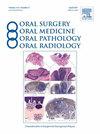Temporary Denosumab Discontinuation Promotes Bone Healing of Osteonecrosis of the Jaw and Minimizes the Invasiveness of Surgery: A Case Presentation
Oral surgery, oral medicine, oral pathology, oral radiology, and endodontics
Pub Date : 2022-02-16
DOI:10.3390/oral2010006
引用次数: 1
Abstract
Denosumab has proved effective at low doses in increasing bone mineral density in osteoporosis patients. In contrast to high-doses antiresorptive therapy, denosumab has a transient effect on the inhibition of the bone remodeling process, suggesting that denosumab-related osteonecrosis is a self-limiting disease, with a high curative potential of surgery when performed after a proper duration of receptor activator of nuclear factor-kB ligand (RANKL) inhibitor suspension. We report the long-term clinical and radiological (Computed Tomography—CT scan) data of a patient affected by secondary osteoporosis (cancer treatment-induced bone loss—CTIBL for metastatic breast cancer) who underwent surgical treatment for stage II denosumab-related osteonecrosis of the upper maxilla 7 months after denosumab suspension. A minimally invasive approach was performed with the extraction of the first right upper molar and debridement of the surrounding alveolar bone. After surgery, the patient was followed up at three-month intervals up to 1 year, and clinical and radiological data (CT scan) were recorded at each follow-up for the early detection of signs of recurrent disease. The mucosal healing remained stable in the long term, with radiological signs of bone remodeling in the post-operative site since the 6-month follow-up. The presented case strengthens the hypothesis that denosumab induces temporary alterations of bone turnover with a predictable curative effect of minimal surgical procedures in cases of denosumab-related osteonecrosis of the jaw.暂时停用地诺单抗可促进颌骨骨坏死的骨愈合,并将手术的侵入性降至最低:一例报告
Denosumab已被证明在低剂量下有效地增加骨质疏松症患者的骨密度。与大剂量抗骨吸收治疗相比,denosumab对骨重塑过程的抑制作用是短暂的,这表明denosumab相关的骨坏死是一种自限性疾病,在适当时间的核因子- kb配体受体激活剂(RANKL)抑制剂悬液后进行手术治疗具有很高的潜力。我们报告了一名继发性骨质疏松症(癌症治疗引起的转移性乳腺癌骨质流失- ctibl)患者的长期临床和放射学(计算机断层扫描- ct扫描)数据,该患者在denosumab停药7个月后接受了上颌骨II期denosumab相关骨坏死的手术治疗。采用微创方法拔除第一右上磨牙,并对周围牙槽骨进行清创。术后每3个月随访1年,每次随访记录临床和影像学资料(CT扫描),早期发现复发症状。黏膜愈合长期保持稳定,术后6个月的随访显示骨重塑的影像学征象。本病例强化了denosumab在denosumab相关颌骨骨坏死病例中诱导骨转换的暂时改变和最小外科手术可预测的疗效的假设。
本文章由计算机程序翻译,如有差异,请以英文原文为准。
求助全文
约1分钟内获得全文
求助全文
来源期刊
自引率
0.00%
发文量
0
审稿时长
1 months

 求助内容:
求助内容: 应助结果提醒方式:
应助结果提醒方式:


